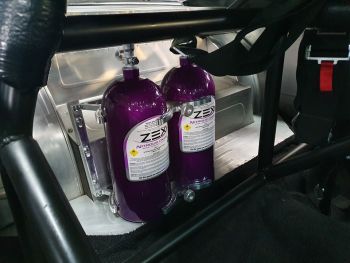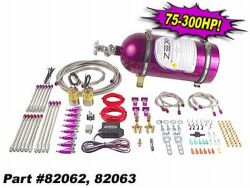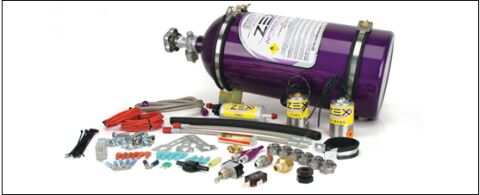Q. How does nitrous oxide create
more horsepower?
A. Nitrous oxide provides the oxygen that allows an engine to burn more
fuel, more burned fuel equals more power.
Q. What is the difference between a wet and a dry system?
A. A "Wet" system introduces a homogenous mixture of nitrous
and atomized fuel into the incoming air stream, thus providing a perfect
air/fuel ratio for each.
Q. Can I still run my car all-motor with nitrous installed?
A. Of course, the nitrous system only affects performance when it is
being used.
Q. How can nitrous blow my engine up?
A. Nitrous in and of itself cannot "blowup" an engine. Nitrous
kits of poor design, poor quality, and improper air/fuel ratios damage
engines.
Q. What is nitrous backfire?
A. Nitrous backfires can be caused by two situations. 1. A nitrous system
that is too rich or a system that atomizes the fuel poorly, thus causing
pooling or puddling of fuel in the intake manifold. 2. A system that
is operated too lean.
Q. What is meant by 30, 50, 100, 150, and 200 shots?
A. "Shot" is commonly used slang in the nitrous community
to refer to the amount of horsepower increase provided by the nitrous
system.
Q. How long can I squeeze nitrous in my engine?
A. With an Nitrous system the only limitation is the capacity of the
N2O bottle or the RPM limit of the engine.
Q. When is the best time to use nitrous?
A. When you want to go fast.
Q. How can a nitrous system be activated (a "happy button,"
automatically, or what)?
A. All Nitrous systems come standard with wide-open throttle switches,
however we offer an electronic TPS switch as well as a push button.
Q. What is the safest way to configure nitrous activation?
A. The only safe way is to use a wide open throttle switch, however
you may configure any number of ways to "trip" the system
but all must be used in conjunction with some type of wide open throttle
switch.
Q. Is a bottle heater good?
A. A quality bottle heater is essential to proper nitrous system performance.
Q. Can I vary the amount of nitrous injected when I want?
A. Yes, by utilizing Nitrous digital progressive controller, the "Maximizer".
This devise allows the user to precisely control the amount of nitrous
delivered to his engine from the comfort of the drivers seat.
Q. Can I install a nitrous system on my car if there is no kit available?
A. There is a system for every car manufactured in the world today.
Q. How much of a horsepower increase can I expect from a nitrous system?
A. All Nitrous systems make within 2% of their claimed horsepower, if
you jet the system for 50 horsepower then you can expect no less than
49 horsepower, but usually a few more than the rated amount.
Q. How long will a bottle of nitrous last?
A. That depends on the level of power being produced. The formula for
calculating your nitrous usage is: 0.8 lbs N2O X 10 seconds = 100 horsepower.
I.E. If your system is jetted for 100 horsepower it will use 0.8 lbs
of nitrous for every 10 seconds of usage.
Q. How much does it cost to get nitrous refills?
A. The cost of nitrous oxide varies with the region of the country,
however a general estimate would be between £6.50 and £8.50
per pound.
Q. What comes with a nitrous kit?
A. Most Nitrous systems come complete with a 10 lb nitrous bottle, stainless
steel bottle brackets, 16 ft aircraft style supply line, N2O filter,
lifetime warranty nitrous and fuel solenoids with mounts, all standard
jet settings, Fogger nozzles, or a carbureted plate, wide open throttle
switch, a complete installation pack that includes all bolts, nuts,
washers, wire, wire terminals, lighted arming switch, and complete instructions
with pictures.
Q. Can I hide my nitrous system from a novice tuner?
A. Yes, it is quite easy to hide an NX system from the casual observer.
Q. Can I use nitrous on my turbo or supercharged vehicle?
A. Yes, I specializes in turbo-supercharged nitrous applications.
Q. What are some general rules for creating the most horsepower without
damaging anything?
A. Generally speaking the amount of power that can be created with nitrous
is almost limitless. To avoid a catastrophe, the internal components
of the engine must match the amount of power that is going to be generated.
The use of proper air/fuel ratios is essential and the quality of the
nitrous system is paramount.
Q. Is a nitrous system worth the money (horsepower per pound wise)?
A. No other devise in the world offers such a bargain as nitrous oxide.
Q. Why doesn't everyone use nitrous?
A. Nitrous is not for everyone, some people prefer turbos, some like
blowers, and others feel it is cheating to use nitrous.
Q. Why does nitrous have such a scary reputation?
A. There has been some very shoddy nitrous "kits" sold to
unsuspecting customers over the last 20 years; this along with the abuse
nitrous has suffered from "idiots" who damage their own engines.
--------------------------------------------------------------------------------
Technical Questions -
Q. How does a nitrous system operate on a carbureted vehicle?
A. The most common method of boosting power on carbureted applications
is the use of a "plate" sandwiched between the carb and the
intake manifold. This plate contains orificed tubes that deliver the
nitrous/fuel mixture in precise ratios.
Q. Purge valves look cool, should I get one for my nitrous vehicle?
A. A purge valve is a valuable tool for increased nitrous performance.
It allows the user to "Purge" all gaseous nitrous from the
bottle supply line prior to using the system. This allows for a harder
"Hit" from the system thus increasing performance.
Q. What are the differences between a dry nozzle and a wet nozzle?
A. The "dry" system uses the factory fuel injection to enrich
the nitrous introduced into the engine. The flaw with this technology
is that no matter how much nitrous arrives at a certain intake port
it always gets the same preset amount of fuel, or if a fuel injector
becomes clogged engine damage will result. The "Wet" technology
introduces a precise amount of fuel and nitrous through a high tech
mixing nozzle that atomizes the fuel to microscopic proportions. This
allows every cylinder to receive a precise, homogenous mixture of fuel
and nitrous, thus insuring a safe, powerful increase.
Q. What is nitrous backfire?
A. Nitrous backfires can be caused by two situations. 1. A nitrous system
that is two rich or a system that atomizes the fuel poorly, thus causing
pooling or puddling of fuel in the intake manifold. 2. A system that
is operated too lean.
Q. Will a bigger bottle give you more horsepower?
A. No; however a larger capacity bottle will provide a more stable bottle
pressure resulting in a lower E.T. and a higher M.P.H.
Q. Why does my engine need more fuel while on the bottle?
A. The fuel, or gasoline, is the source of the additional horsepower.
The nitrous' job is to provide the oxygen to allow the fuel to be burned.
Q. What is the safest way to configure nitrous activation?
A. The only safe way is to use a wide open throttle switch, however
you may configure any number of ways to "trip" the system
but all must be used in conjunction with some type of wide open throttle
switch.
Q. Is a bottle heater good?
A. A quality bottle heater is essential to proper nitrous system performance.
Q. How much pressure should be in my bottle?
A. Mostl Nitrous systems are designed to operate between 900-1050 PSI.
Q. Are there any dangers or things to stay away from while using nitrous?
A. Of course,most Nitrous companys recommends that no more than an additional
20 horsepower per cylinder be used on a stock engine, with a stock fuel
pump. Always be sure you are using clean, uncontaminated nitrous. Also,
be sure you have the highest octane fuel available, I.E. 93 octane premium
for, stock compression, street cars and the highest motor octane fuel
available for competition type vehicles.
Q. Is there a trade off for engine reliability and power produced with
nitrous?
A. When used according to factory recommendations, shortened engine
life should not be a concern.
Q. Can you feed an engine too much nitrous even if you keep the air/fuel
ratio the same?
A. Yes, if the mechanical limits of the engine are exceeded catastrophic
engine failure will result.
Q. Can I use a nitrous kit on an automatic?
A. Yes, the preferred application, for nitrous, is an automatic transmission
equipped vehicle.
Q. Can you powerbrake an automatic with nitrous without it blowing
up?
A. The answer is a qualified, yes. If your brakes can hold your engine,
at full throttle, with the nitrous on, the answer is yes, but it is
doubtful this would be possible.
Q. Can a nitrous system be set up to shut down once the brake is depressed?
A. Yes, if the user wires his system with a double throw-double pole
relay placed between the arming switch and the wide open throttle switch
that is activated when the brakes are applied.
Q. Can nitrous systems be used with aftermarket chips or ECU's?
A. Yes, however close attention must be paid to excessive timing advance
that could cause detonation.
Q. How high must the RPM's before activating nitrous?
A. The RPM level is not as important as is the motors ability to rev
freely when the nitrous is engaged, I.E. If the vehicle is in low gear,
nitrous can be engaged at any time, but if the vehicle is in a higher
gear moving at a slow speed when the nitrous is engaged the engine will
detonate and damage will occur.
Q. Does nitrous increase cylinder temperatures and combustion chamber
pressure?
A. No, cylinder temperatures should stay the same when the correct nitrous
air/fuel ratio is used. Yes, increased cylinder pressure equals increased
horsepower.
Q. Can I use nitrous on my high compression engine?
A. Yes, but the proper octane fuel must be used to prevent detonation.
Q. What if the pressure is too high, should I cool it?
A. If the bottle pressure is in excess of 1100 PSI the bottle should
be cooled using a wet towel or chamois.
Q. Is there any harm that can be done to my engine if I use nitrous
while the bottle pressure is too high?
A. Yes, the nitrous system will run "lean" if the nitrous
pressure is high beyond specification. This could cause severe engine
damage.
Q. Where should I run the main nitrous feed line?
A. The feed line can be run either under the car of through the passenger
compartment. Care should be taken to route the line away from any voltage
points or moving suspension parts.
Q. Where should I install my bottle?
A. The ideal place to mount the bottle is in the trunk; however if your
car is a hatchback it is permissible to mount it in the passenger compartment
if an external pressure relief vent is properly installed on the bottle.
Q. What if my bottle leaks while I'm driving, could I get busted for
OWI?
A. To become, "intoxicated", the nitrous leak would have to
be severe and noticeable. No excuses to be found here!
Q. Is a nitrous system worth the money (horsepower per dollar wise)?
A. No other devise in the world offers such a bargain as nitrous oxide.
Q. Why does nitrous have such a scary reputation?
A. There has been some very shoddy nitrous "kits" sold to
unsuspecting customers over the last 30+ years; this along with the abuse
nitrous has suffered from "idiots" who damage their own engines.
| 



